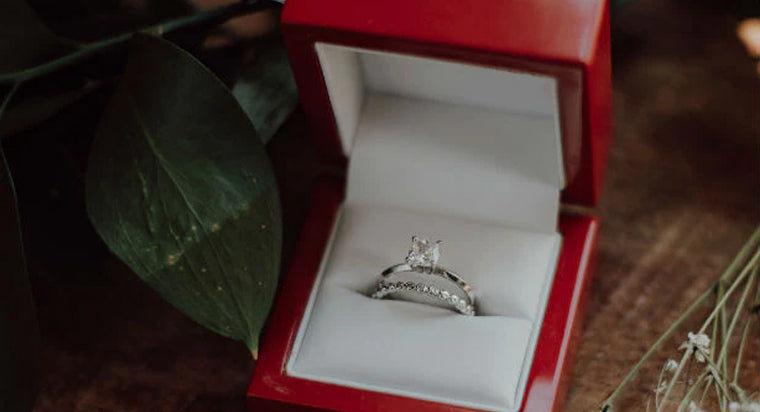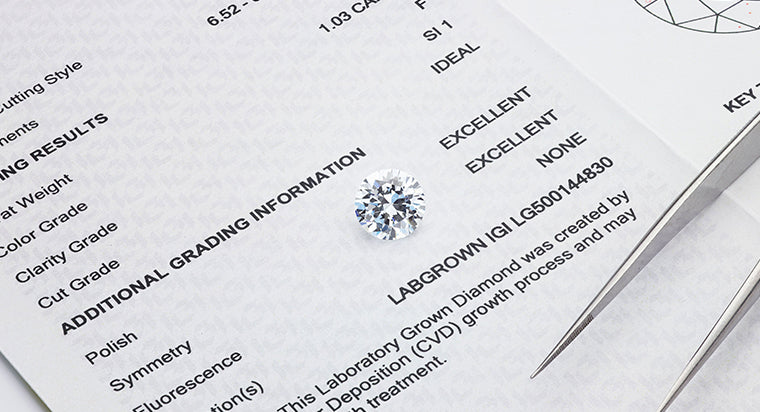How are Lab Diamonds Environmentally Friendly

If you find yourself shopping for diamonds in this earth-conscious era, you will no doubt have heard of some of the issues related to natural mined diamonds. Some people consider mined diamonds ethically dubious due to the ethical dilemmas associated with this practice and the physical damage that mining creates in the environment. While this was more true in decades past, diamond mining practices and rules have since been implemented that make the industry much more regulated, safe and fair.
Though some people will consider a lab-created diamond to be less real than a mined diamond, it should be noted that all diamonds, mined or lab-created, are actually “real” diamonds. A lab-created diamond is simply a diamond that has been created through mimicry of the natural conditions that create a diamond deep within the earth's core. All diamonds, whether mined or lab-created, are essentially the same. All diamonds have the same physical, chemical, and optical properties.
TABLE OF CONTENTS
As the creation of a naturally mined diamond requires approximately one to three billion years of incubation nestled about 100 miles beneath the earth’s crust to form, these gemstones require a great deal of time and expense to extract. And clearly, extracting gemstones from the depths at which they occur is both costly and creates a great deal of damage to the areas surrounding mining sites.
How are Lab-created Diamonds Made?
There are two options when it comes to creating lab-grown diamonds. Created diamonds may be created using either the High-Pressure High Temperature (HPHT) method or the Chemical Vapor Deposition (CVD) method.
HPHT Method of Creating Lab Diamonds
This is the original method used to create lab-grown diamonds and was introduced in the 1950s. To create a diamond using this method, a small diamond seed is immersed in carbon. The diamond seed is then placed under extreme heat and pressure. When the carbon surrounding the diamond seed melts, at temperatures in excess of 2,000 degrees Fahrenheit, it forms a diamond around the seed. Once the lab-created diamond has cooled, it can be cut and shaped exactly as a naturally mined diamond would be.
CVD Method of Creating Lab Diamonds
Dating to the 1980s, the CVD method of creating a diamond uses less pressure than the HPHT method. To create a diamond by this method, a diamond seed is inserted into a vacuum chamber. The chamber is then filled with carbon-rich gasses and heated to approximately 1500 degrees Fahrenheit. At this temperature, the gas forms a plasma and releases pieces of carbon that create layers about the diamond seed causing the diamond to grow in size.
Lab Grown Diamond and the Environment
As we have discussed above, lab-created diamonds are real diamonds that are created without a need for mining. This means that lab-created diamonds can be produced without expending the resources need to unearth them thereby making them both more sustainable and allowing companies that create and sell created diamonds to avoid some of the ethical issues related to the mining of gemstones.
Another lovely side-effect of lab-created diamonds is that they can be created for less than a natural diamond can be mine. Therefore, when you shop for lab-created diamonds you will find that you can afford a larger more visually impressive diamond for less cost than you would if you were buying a mined diamond.
Even without the focus on the economic value of a lab-created diamond, many environmentally conscious people will prefer to own a lab-created diamond due to the fact that they don’t require the amount of damage that mining creates. For every carat of lab diamond that is created, nearly, 100 square feet of land is saved from being cleared. This disruption often leaves land unusable due to the waste associated with mining. For Each carat of lab diamond created, over 5000 pounds of mineral waste is saved from being created.
Add to this the fact that lab-created diamonds will cost you between 30 and 50% less than a mined diamond and that lab-created diamonds are conflict-free by nature, you will see why so many people are choosing jewelry made with lab-created diamonds over jewelry featuring naturally mined diamonds.
Tips for Finding the Best Lab-created Diamond Jewelry for You
Although you will find lab-created diamonds a cost-effective alternative to naturally mined diamonds, you may also reduce the amount of bite a piece of diamond jewelry takes out of your budget by choosing a diamond that has a bit lower clarity. So long as your diamond’s inclusions remain invisible to the naked eye, they should not impact your enjoyment of your diamond jewelry.
Be sure that you are buying your lab-created diamond jewelry from a brand that you are comfortable with. Reputable brands will work with you to ensure your satisfaction with the diamond you buy. Make sure the brand you are buying from allows for hassle-free returns.
You will also want to ensure that you are working with a company that has their lab-created diamonds certified by IGI or GIA so you can be confident in the quality of the diamond jewelry you are investing in.
If you’re looking to purchase a natural diamond, you can also do so without apprehension when working with a credible jeweler. A reputable jeweler will be able to offer you a return policy, information about their diamond sourcing, options to get your diamond appraised and of course the original certification of the diamond. This will ensure that you have a diamond you love with peace of mind.
FAQs
Are lab diamonds really ethical?
Since lab-created diamonds don’t require mining, they eliminate all of the cost and ecological damage associated with diamond mining. This clearly makes lab-created diamonds a more sustainable alternative to mining natural diamonds. For each lab-created diamond, over one hundred gallons of water are saved. Buying a one-carat lab-created diamond also saves up to 250 tonnes of land, and creates up to 1.5 billion times less carbon to be emitted into the environment.
Is a lab diamond the same as an earth-mined diamond?
Lab-created and earth-mined diamonds are both “real” diamonds. Both lab-created and natural diamonds are made of the same substance and have the same physical, chemical, and optical properties.
Are lab diamonds conflict-free?
Yes. Unlike natural mined diamonds, lab-created diamonds are conflict-free. A conflict-free diamond is simply a diamond that has not contributed to the financial support of civil wars. If you are particularly interested in making an ethical purchase when buying a diamond, you may wish to look for diamonds that are ethically sourced or lab-created, as even mined diamonds that are designated conflict-free can be associated with ethically dubious practices.
Does a lab diamond have flaws?
Standard (also known as princess) length necklaces (18") are the most common necklace length and suits most occasions. If Just like natural mined diamonds, lab-created diamonds will also have flaws and imperfections. You will find that lab-created diamonds are graded according to the 4C’s just as naturally occurring diamonds are. Your lab-created diamond can and should be certified by top organizations, like the GIA and IGI.







